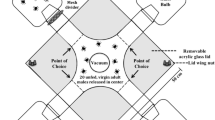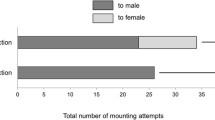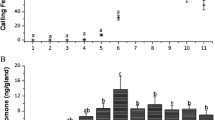Abstract
The presence of a mounting sex pheromone was demonstrated on the surface of fed female Rhipicephalus appendiculatus. This pheromone, which is present on the female cuticle, allows the male to recognise the female. The pheromone was removed by cleaning the female in hexane, resulting in the loss of male mating behaviour in in vitro experiments. Male mating behaviour was resumed when extract made from fed female cuticle was replaced on cleaned females. When the extract was transferred to innanimate objects typical male mating behaviour was released. Preliminary chemical analyses indicated that the active component of the extract was contained in the sterol ester fraction of the extract.
Similar content being viewed by others
References
Allan, S.A., Phillips, J.S. and Sonenshine, D.E. 1991 Role of genital sex pheromones in Amblyomma americanum and A. maculatum (Acari: Ixodidae). Exp. Appl. Acarol., 11, 9–21.
Andrews, R.H. 1982 Mating behaviour and reproductive isolation of three species of reptile tick. Anim. Behav., 30, 514–524.
Berger, R.S. 1972 2,6-Dichlorophenol, sex pheromone of the Lone Star tick. Science, 177, 704–705.
Dusbábek, F., Jegorov, A. and Simek, P. 1991 Artificial assembly pheromone of argasid ticks (Ixodoidea: Argasidae). In: Dusbábek, F. and Bukva, V. (Eds.), Modern Acarology. Academia Prague and SPB Academic Publ. bv, The Hague, Vol. 1: 59–68
Hamilton, J.G.C. 1992 The role of pheromones in tick biology. Parasitology Today, 8: 130–133.
Hamilton, J.G.C. and Sonenshine, D.E. 1988 Evidence for occurrence of mounting sex pheromone on body surface of female Dermacentor variabilis (Say) and D. andersoni (Stiles) (Acari: Ixodidae). J. Chem. Ecol., 14, 401–410.
Hamilton, J.G.C., Sonenshine, D.E. and Lusby, W.R. 1989 Cholesteryl oleate: mounting sex pheromone of the hard tick Demacentor variabilis (Say) (Acari: Ixodidae). J. Insect Physiol., 35, 873–879.
Lancaster, J.L. and Meisch, M.V. 1986 Arthropods in livestock and poultry production. 1st Ed, p402. Chichester: Ellis Horwood Ltd.
Phillips, J.S. and Sonenshine, D.E. 1993 Role of the male claw sensilla in perception of female mounting sex pheromone in Dermacentor variabilis, Dermacentor andersoni and Amblyomma americanum. Exp. Appl. Acarol., 17, 631–653.
Silverstein, R.M., West, J.R., Sonenshine, D.E. and Khalil, G.M. 1983 Occurrence of 2,6-dichlorophenol in hard ticks, Hyalomma dromedarii and H. anatolicum excavatum, and its role in mating. J. Chem. Ecol., 9, 1543–1549.
Sonenshine, D.E. 1985 Pheromones and other semiochemicals of the acari. Ann. Rev. Entomol., 30, 1–28.
Sonenshine, D.E., Hamilton, J.G.C., Phillips, J.S. and Lusby, W.R., 1991 Mounting sex pheromone: its role in regulation of mate recognition in the Ixodidae. In Modern Acarology, Vol. I. (eds. Dusbábek, F. and Bukva, V.). pp. 67–78. Academia, Prague and SPB Academic Publishing, The Hague.
Sonenshine, D.E., Silverstein, R.M., Layton, E.C. and Homsher, P.J. 1974. Evidence for the existence of a sex pheromone in two species of Ixodid ticks (Metastigmata: Ixodidae). J. Med. Entomol., 11, 307–315.
Sonenshine, D.E., Silverstein, R.M., Brossut, R., Davis, E.E., Taylor, D., Carson, K.A., Homsher, P.J. and Wang, V.B. 1985. Genital sex pheromones of Ixodid ticks: 1. Evidence of occurrence in anterior reproductive tract of American dog tick, Dermacentor variabilis (Say) (Acari: Ixodidae). J. Chem. Ecol., 11, 1669–1694.
Sonenshine, D.E., Silverstein, R.M., Collins, L.A., Saunders, M., Flynt, C. and Homsher, P.J. 1977 Foveal glands, source of sex pheromone production in the Ixodid tick Dermacentor andersoni Stiles. J. Chem. Ecol., 3, 695–706.
Sonenshine, D.E., Khalil, G.M., Homsher, P.J. and Mason, S.N. 1982 Dermacentor variablilis and D. andersoni: Genital sex pheromones. Exp. Parasit. 54, 317–330.
Wood, W.F., Leahy, S.M.G., Galun, R., Prestwich, G.D., Meinwald, J., Purnell, R.E. and Payne, R.C. 1975 Phenols as pheromones of Ixodid ticks: A general phenomenon. J. Chem. Ecol., 1, 501–509.
Author information
Authors and Affiliations
Rights and permissions
About this article
Cite this article
Hamilton, J.G.C., Papadopoulos, E., Harrison, S.J. et al. Evidence for a mounting sex pheromone in the brown ear tick Rhipicephalus appendiculatus, Neuman 1901 (Acari: Ixodidae). Exp Appl Acarol 18, 331–338 (1994). https://doi.org/10.1007/BF00116314
Accepted:
Issue Date:
DOI: https://doi.org/10.1007/BF00116314




